Back in 2015, I was reading one of Nicole “Tea For Me Please” Martin’s weekly roundups. In those, she lists off her five favorite tea blog articles of that week. I happened to be reading it that day to . . . see if I made the cut. (Yes, I’m narcissistic.) But I soon got distracted by one of the articles she linked to. It talked about a tribe of people in Assam, India I’d never heard of before— the Singpho.

They are an ethnic group that are part of a larger set of “Kachin people”, and they are spread out in parts of Myanmar, China, and—of course—India. Their genetic diversity, migration path, tribal delineations, and societal hierarchies are varied and fascinating. But this is a tea blog . . . and I only have so much time (and word count). However, if you wish to know more, I’d start with the article I linked to above.
Why did that particular article catch my eye? Well, it turns out, that—prior to the blustery arrival of the British—the Singphos had been making tea from wild assamica tea trees since the 12th century C.E. Sometimes it was just their take on what we think of as green tea, other iterations were much, much different. I just didn’t know I needed it in my life until two years later. Entirely by accident.
I was having tea with fellow tea merchant/guru, Dan Pappas, and he regaled me with tales of his journey to China for the Xiamen International Tea Industry Fair, which was like World Tea Expo times . . . I dunno, some ridiculously large number. While there, he happened by a booth for a company called Tea Leaf Theory, manned by a guy named Upamanyu Borkakoty. The name sounded familiar.
Dan said he had “something weird” to pass onto me. He had no other way to describe it other than that it was—in his words, paraphrased slightly—“kinda like a smoked puerh”. He opened the bag, I looked inside . . . and was greeted by the scent of herbs and smoke.

The tea was called “Phalap” (or “Falap”), and that translated to . . . y’know, I have no idea. Let me Google it really quick.

Huh . . . it just means “tea” in the Singpho language. Well, that’s anticlimactic. Moving on.
The process for making Phalap is an enigma all its own. First, tea leaves are plucked from (supposedly) wild trees. In the past, Singpho tribal folk would mount elephants and pick tea leaves from the ten-feet-plus-tall trees that grew wild along the Indo-Myanmar border. Today, it is more likely that trees are grown “semi-wild” on private property, un-pruned.
After that, the leaves are fried over a metal pan until browning occurs. Once the right color, they are then put out in the sun to dry for a few days—like puerh maocha. However, this next part? This is where things get really weird and wonderful.
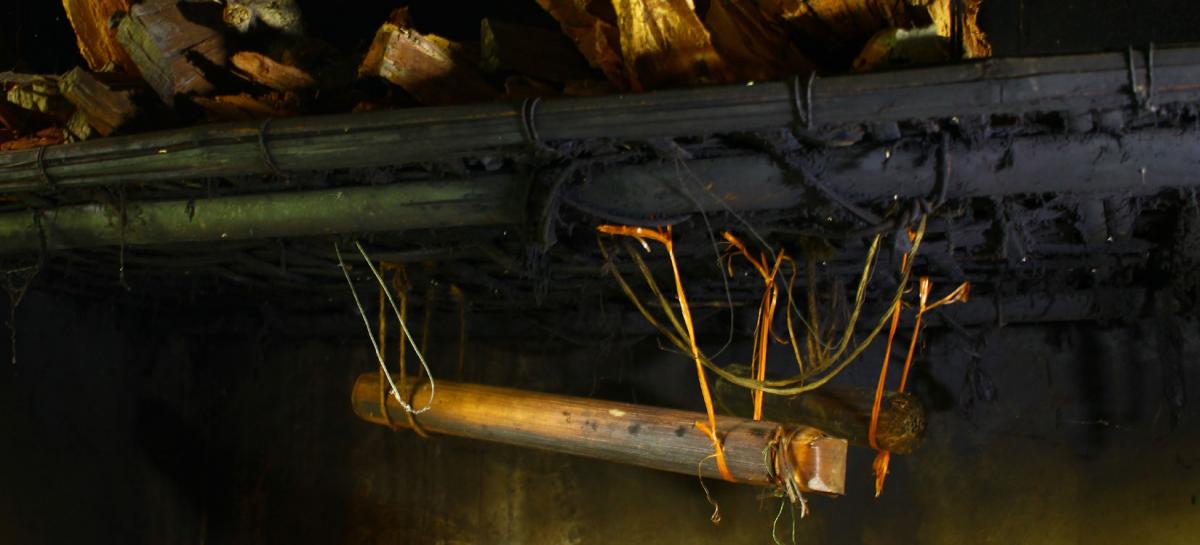
The sun-dried leaves are packed into bamboo tubes and then smoked for an extended period of time. By the end, the tubes are placed in a dhuwa chang (“cooking pit”) for about a week. When all is done, the tubes are stored for aging. There are cases of Phalap tubes being stored for up to a century.
Even after Dan gave me a sample, and I smelled it, I knew I wanted to buy it. And I did. A week later.
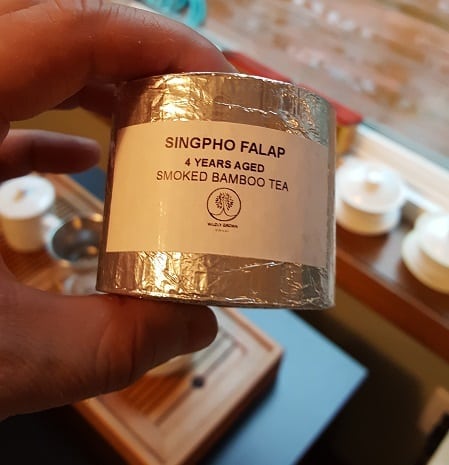
A week or so after that, I got a message from Upamanyu telling me that the package was on its way. He humbly requested that I do an unboxing video when the package arrived. And I did. I even brewed up some Phalap during it.
(You don’t have to watch the whole thing. Seriously, it’s really long. The tasting occurred around the fifteen-minute mark.)
Short version: I loved the stuff. It reminded me of an oak-smoked Assam green tea I had years prior. Only stronger; a lot stronger, but I felt I needed to do a more careful “analysis” later.

As mentioned above, the first thing one notices, of course, is the smell. The smoky aroma pounced out of the bag like a tiger made of stove exhaust. The aroma was very similar to Lapsang Souchong in that way, except it was more woody than piney in the smoke-scented delivery. The leaves themselves looked as heicha as heicha could get—off-green, pressed, flaky . . . and old. If I was looking at this with no info, I would’ve concluded it was a bamboo-wrapped Liu Bao or something.
For brewing, I had . . . no clue how to approach this. So, I opted to treat it like I would any other heicha. Gongfoolishly. A teaspoon of leaf material in a 6oz. gaiwan; three successive steeps at thirty seconds or more, boiled water at the ready. At the very least, it would further gentle out the smoke to expose other nuances.
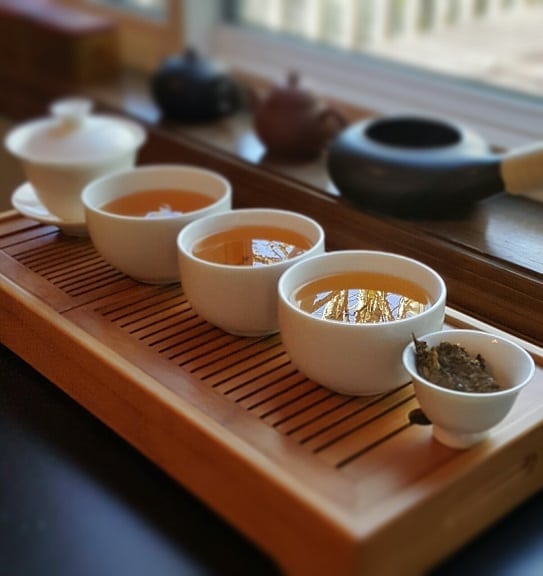
The first three infusions brewed up with magnificent, amber liquors. Aromatically, all I could think was, “This smells like whiskey-basted steak.” I should know that smell by now, given how many barrel-aged teas I’ve had. But differences from Lapsang (or anything else) really showed up in the flavor. The whiskey comparison was there, but even the peat aspect was muted by an overall . . . gentleness.
Hard to explain, but tasting it kind of reminded me of a very comfy easy chair in my grandfather’s study. And said grandfather was a pipe tobacco smoker. The good stuff, not the cheap, flaky mini-mall crap. Smoke took up the intro of the taste, leading to a meatier middle, and trailing off with a gentle, smoke-wispy calm.
Later, I found out that I’d been brewing it wrong the entire time. Sure, one could brew it like a regular Assam . . . or a heicha. But the Tea Leaf Theory instructions were a bit different. And by that, I mean, very different. They recommended 1 gram of leaf per 8oz. of boiled water, and a steep time of five minutes. I did it wrong. Both times!
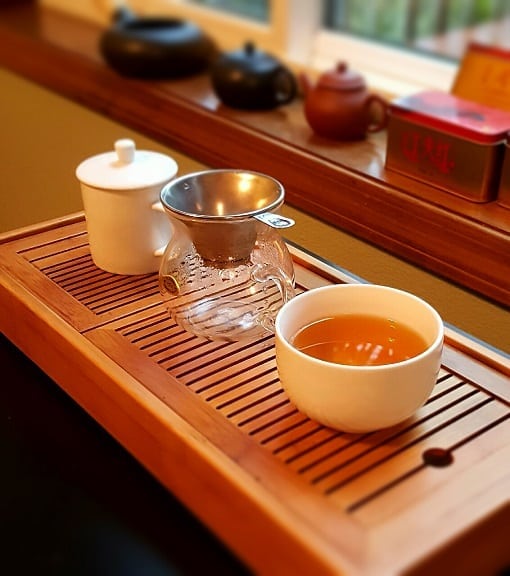
At the right recommendations, the liquor brewed the same mighty amber as before, and the smoke was still there on the steam aroma. But on first sip, I was greeted by something profoundly different. Instead of something overly peaty, or understated on the toastiness, it was a perfect balance of . . . malt, grass, smoke and . . . something floral. In short, it was lovely.
I don’t have much else to say here. Is this tea easy to categorize? Nope. Is it heicha or green tea? No idea. Do I want more? Oh, God yes!
The wild tea tree crescent that swaths the edges of Myanmar, India, China, Laos, Vietnam and Thailand allows for many treasures. This is one of them. And it all started because of a Top Five list. You can’t get more “Internet” than that.
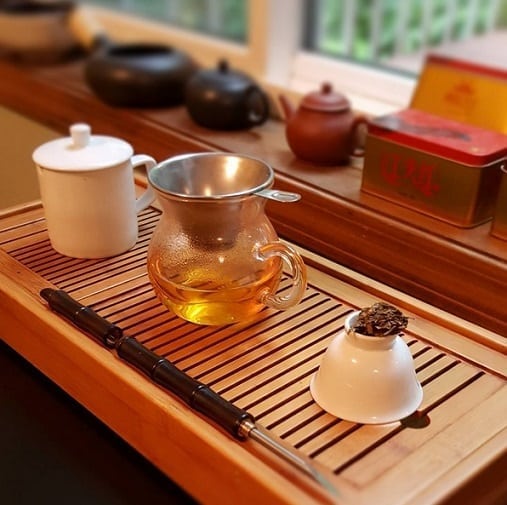
To buy Singpho Phalap, go HERE.
(Just save some for me, will ya?)
Leave a Reply